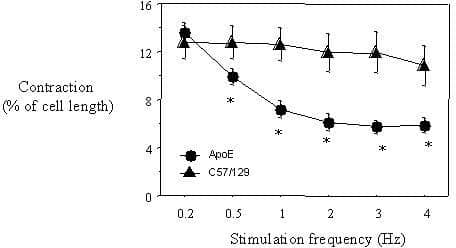Deletions of the genes for apolipoprotein E (ApoE-/-) result in severe atherosclerosis, with the formation of lesions strikingly similar to those found in humans (Breslow 1996; Johnson & Jackson, 2001). ApoE-/- mice fed on a high fat diet show lesions in the coronaries and evidence of myocardial infarction (Williams et al. 2002). Nothing is known about the characteristics of the myocytes in these diseased hearts. The aim of this work was to isolate myocytes from ApoE-/- (fed on high fat diet) and their strain-matched, age-matched wild-type (fed on normal chow) mice and to compare their morphology and contractile properties. ApoE-/- mice (7-8 months old) fed on a high fat diet for 5-6 months and their matched wild-type mice were humanely killed, and the hearts were removed and perfused in the Langendorff mode. Myocytes were enzymatically isolated as described previously (Williams et al. 2001). Isolated myocytes were perfused with Tyrode solution and field stimulated at different frequencies at 37°C. Cell length measurements were made using an edge detector. All results are expressed as mean ± S.E.M. and analysed using an unpaired t test. Myocytes from ApoE-/- mice were significantly (p<0.05) shorter in length and width than wild-type mice (112±3 vs. 142±5 μm in length and 23.9±0.9 vs. 28.8±1.6 μm in width, n=30-70 myocytes isolated from 6 hearts from each group). When myocytes were stimulated at 0.2 Hz, there was no difference in the amplitude of contraction (% of cell length): 12.7±1.3 vs. 13.5±0.8%, for ApoE-/- and wild-type mice, respectively). However, upon increasing the rate of stimulation there was a significant decrease in the amplitude of contraction in ApoE-/- but not in wild-type myocytes (Fig. 1). Furthermore, at higher frequencies, the diastolic length of the myocytes decreased in ApoE-/- but not in wild-type. In conclusion, this work shows that myocytes of ischaemically diseased hearts have different characteristics from wild-type. Further investigation is required to ascertain whether myocytes from ApoE-/- mice fed on chow diet (control) display similar characteristics. This work may have clinical implications for patients with coronary heart disease.
University of Bristol (2005) J Physiol 567P, PC17
Poster Communications: Morphological and contractile characteristics of myocytes isolated from apolipoprotein E knockout mouse heart
Chase, Anabelle; Jackson, Christopher L; Angelini, Gianni D; Suleiman, M. Saadeh;
1. Bristol Heart Institute, University of Bristol, Bristol, United Kingdom.
View other abstracts by:
Figure 1.
Where applicable, experiments conform with Society ethical requirements.

